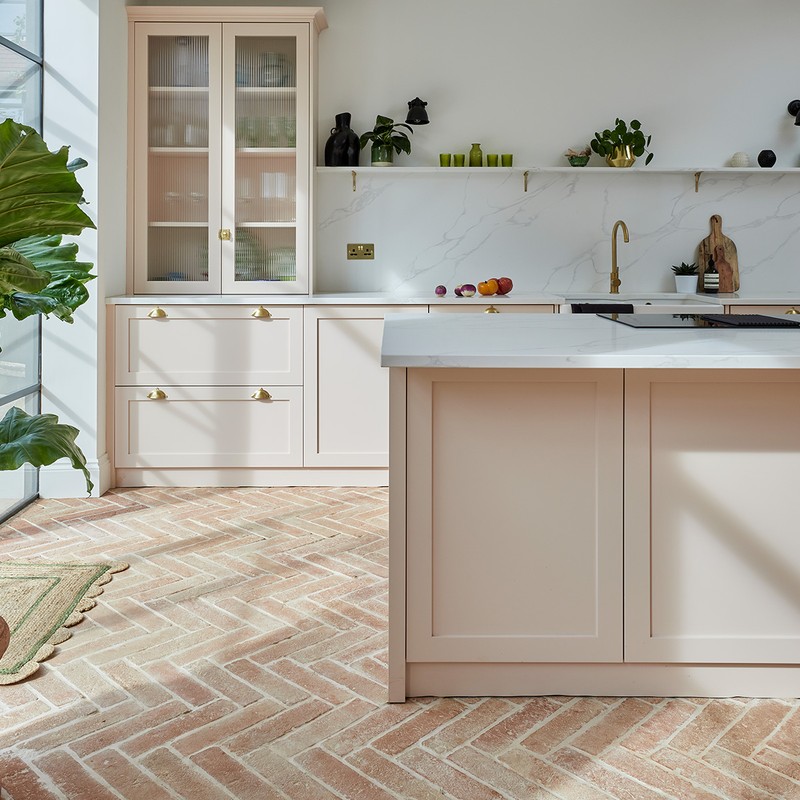8 Kitchen Flooring Options To Know About

LIMESTONE TILES
“Limestone is very versatile. It works well in so many areas, including the kitchen. The beauty of limestone is that it is a natural stone, so it becomes lived in and ages beautifully. If you are looking for something truly timeless, it’s a great choice.
“When it comes to natural stone, however, it’s always worth thinking about how the space is going to be used. Is it a high traffic commercial space, a slick apartment or a country home? Who will be using the space? And what is your lifestyle like? Sometime a contemporary space calls for a very clean and consistent colour, while a family home might suit a more characterful limestone floor with fossil content, texture and tonal variation. What’s great is you can choose a more contemporary or a more aged finish to suit your home.
“Natural stone will need sealing to ensure the surface of the tile is protected. This mostly comes in the form of an impregnator which fills the pores in the stone to make it impermeable to stronger colours. Lay the floor, seal it, look after it by vacuuming and washing as you would with any other floor and it will stand the test of time. Limestone also works with underfloor heating, but make sure it’s laid by a professional.”
- Grazzie Wilson, Head of Creative at Artisans of Devizes
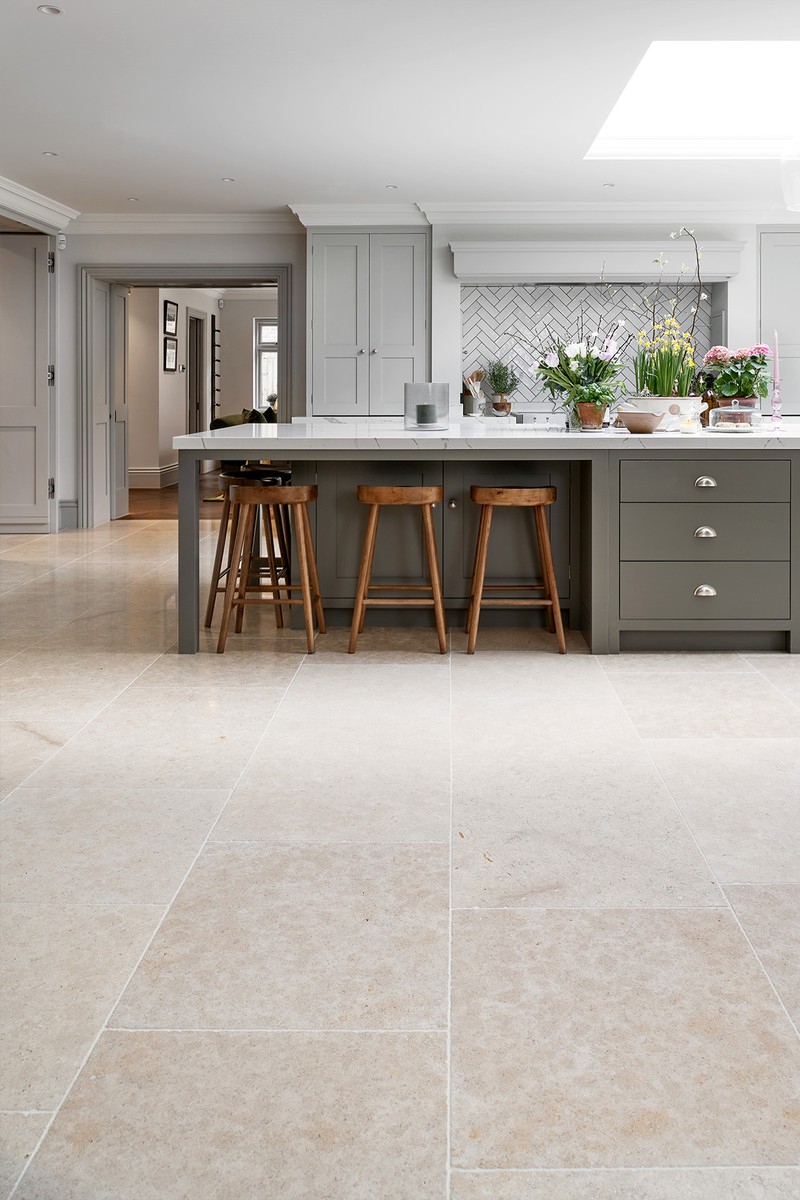
PORCELAIN TILES
“Porcelain tiles are made from a mixture of clays and minerals, fired at a very high temperature to make them extremely hard-wearing and strong. Porcelain floor tiles are the ultimate low-maintenance option for a busy kitchen space; they don’t require sealing or any special treatment, and they can be cleaned with a regular floor cleaning solution. They are water resistant, so you don’t need to worry about drips and spills, and their hard-wearing properties make them durable enough for a high-traffic area.
“The options are endless and we’ve curated a beautiful collection of tiles of all shapes and sizes, colours, patterns and finishes to create your perfect kitchen. They work well with underfloor heating and the variety of options mean you can tailor the style to your kitchen. We would recommend getting porcelain tiles professionally laid to achieve the best finish, though.”
- Krista Cowen, Brand Manager at Ca’ Pietra

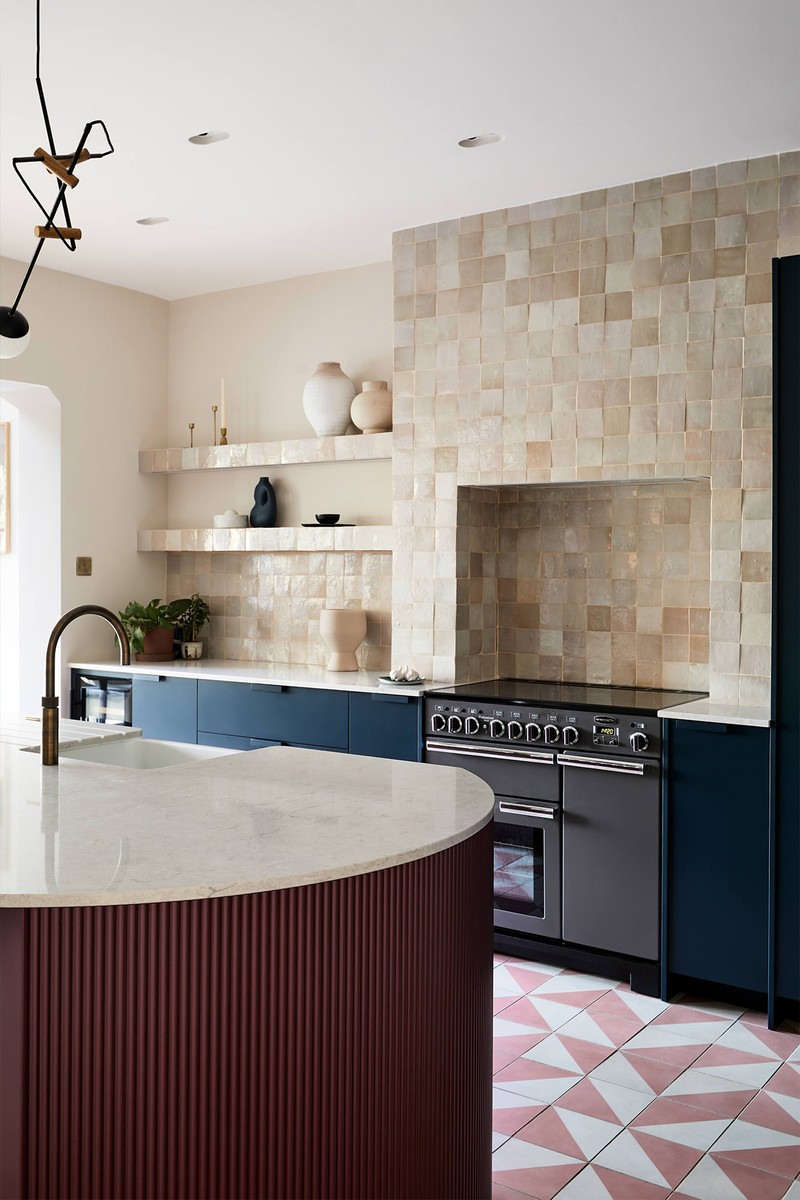
ENCAUSTIC TILES
“Encaustic tiles are made from high-quality marble, cement, sand and natural pigments. With a patterned encaustic tile, the pattern forms the body of the tile rather than sitting on the surface, which means the tiles have a long life and take on patina over time, so they work very well in a kitchen.
“Encaustic tiles are readily available new or reclaimed. New tiles need to be sealed before laying to prevent them from staining, and it's recommended you reseal them every 12-18 months to keep them looking their best. A reclaimed encaustic tile is particularly resilient and is less likely to show stains or blemishes due to the patina they’ve already taken on.
“Encaustic tiles are much thicker than porcelain or ceramic, so they withstand impact much better. There is an amazing array of options ready to purchase, but there are also suppliers that will make them bespoke for you. With so many styles and designs to choose from, they really can work with most kitchen looks, whether classic or contemporary. Encaustic tiles are generally more expensive than porcelain or ceramic as the process of making them is far more labour intensive. On average, you're looking at around £70 per square metre upwards. Encaustic tiles generally work brilliantly with underfloor heating as they conduct and retain heat very well, but always check with your installer first.”
- Andrew Griffiths, Founder of A New Day

PENNY TILES
“Despite their diminutive size, small hexagon or penny tiles can have an enormous impact on a space. They can be a great way to inject some fun and personality – even more so if you play with the grout colours. Hard wearing and easy to clean, especially with a steam mop, they are a good flooring option for kitchens, especially open plan ones where a change in flooring can help to zone the space. Furthermore, builders tend to like to lay these tiles as they come on a flexible fibreglass mesh making them easy and lightweight to handle and relatively quick to install.”
- Oana Sandu, Lead Designer at Blakes London
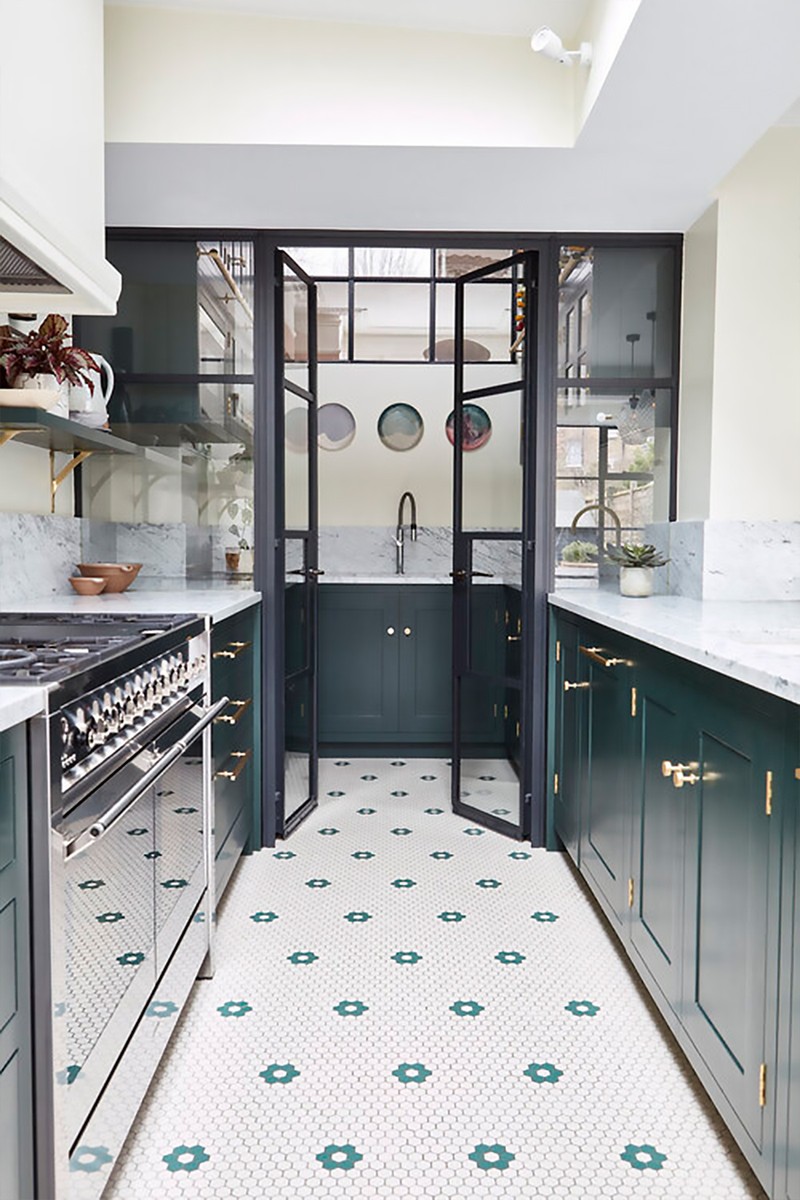
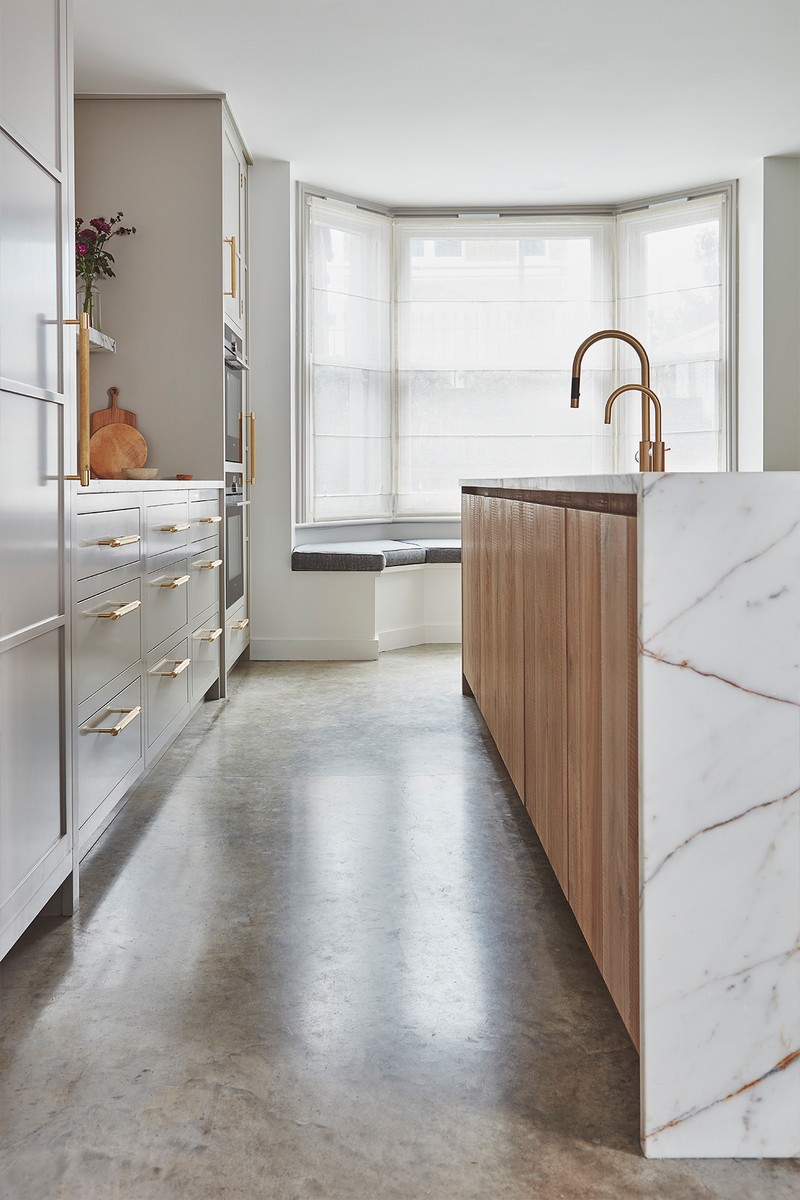
CONCRETE
“Concrete floors are a wonderfully versatile option for a kitchen and work well with almost any aesthetic. Add extra aggregate and you can achieve a rougher pebbly look which is popular on the continent, and works well for a more relaxed farmhouse property. If it’s a more contemporary vibe you’re trying to achieve, then an ultra-fine mix in a dark finish can be equally striking. Clients tend to prefer a gloss finish, however the more gloss the more slippery the floor will become, so there is a balance to be found. We don’t advocate anything too matte, as the floor can end up looking somewhat unfinished.
“There are two ways to achieve a concrete floor effect and the type of home you have will play a big part in determining which option is right for you. A poured concrete floor needs to be specified at the beginning of the build, as it forms the structure of the building. Around 100mm thick, a concrete screed is poured over the under-floor heating. As the concrete dries, it is polished four to six times at specific stages within its curing process – which makes it a very labour intensive, artisanal job and therefore needs to be done by a specialist rather than a builder. For this reason, poured polished concrete tends to be an expensive option and is only suitable for new builds or extensions.
“If you don’t have 100mm of depth for a poured concrete floor, and you wish to retrofit this look into an existing structure, one alternative is a concrete micro topping. Also known as a micro cement, this type of floor only requires 2-3mm of depth and can be laid towards the end of a build just before the kitchen goes in. The downside of this option is that should something heavy drop and the topping becomes dented or damaged, the substrate is usually revealed, which is then difficult to repair. With a poured concrete floor, a chip or dent reveals more concrete which just adds character to the floor.
“Thankfully, once laid, a concrete floor is relatively easy to maintain and doesn’t need re-varnishing or waxing in a way that a timber floor might. That said, even with its protective finishing sealant, it is a porous surface that will stain, so spills should be mopped up quickly. The key thing to remember with a concrete floor is that it will likely pick up a few hairline cracks, it will stain and it will evolve and patina over time, which is all part of its charm. If you’re looking for a perfect finish that won’t change, you may wish to consider a concrete-effect porcelain tile which will also be a bit budget friendlier.”
- Jennifer Hamilton, Director at The Vawdrey House
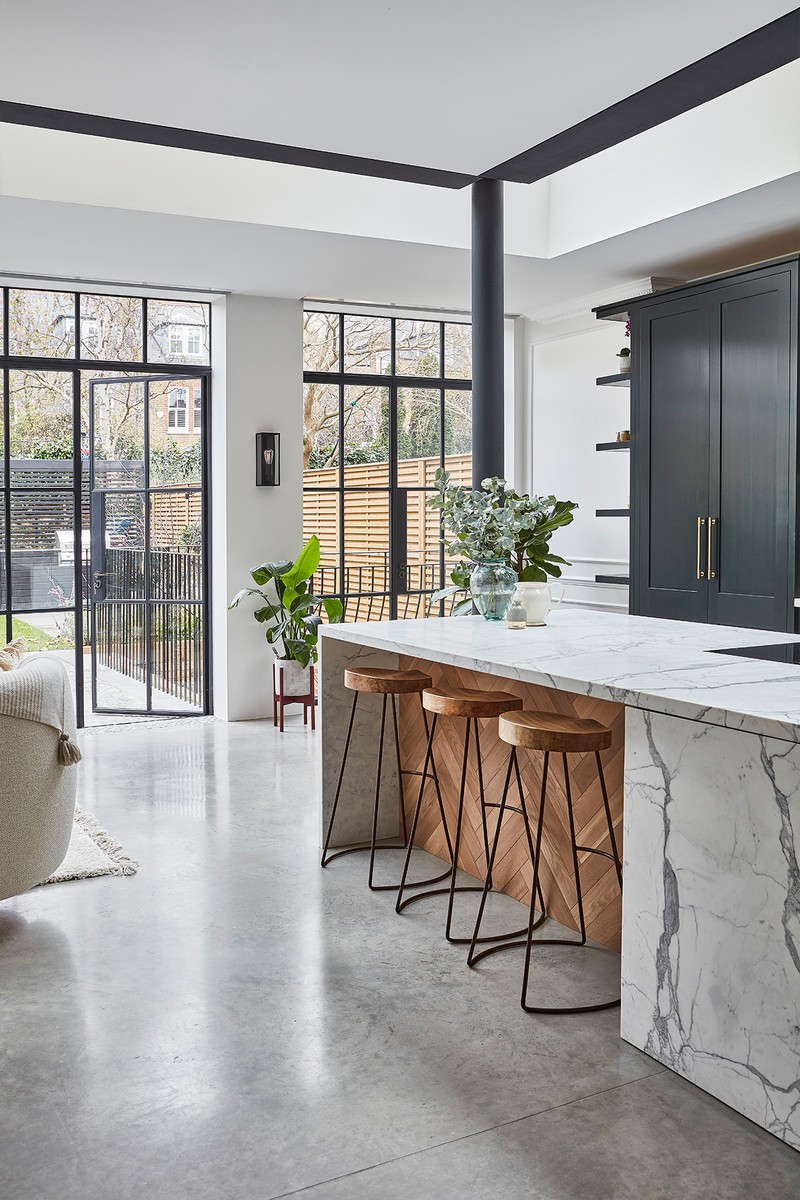
CORK
“A kitchen is often a room in which we spend most of our time, so the flooring needs to be durable, easy to maintain and able to withstand heavy foot traffic. A natural material like cork is a great choice as it isn’t only functional and comfortable to walk on; it introduces an organic element and it’s truly sustainable.
“Recork flooring is installed by permanently gluing it to the subfloor using a special contact adhesive. After installation, the floor needs to be covered with at least one layer of special coating to seal all the joints between the modules and ensure longevity.
“Cork is easy to maintain. In a kitchen, just wipe spills up promptly with a damp cloth or mop, then vacuum or dust mop as needed to remove any loose dirt. Periodically recoat your floor when it starts to show signs of wear and tear. Cork is water resistant, but not 100% waterproof so it needs to be protected from excess moisture. It is extremely durable and hard wearing. Once the surface is primed with a specially developed precoat that allows the cork core to flex and absorb impact, it is scratch resistant and offers outstanding chemical and wear resistance. Due to cork’s natural elasticity and compressibility, it is very hardwearing and will bounce right back if something heavy is dropped on it, quickly recovering and keeping its initial shape.
“As cork is a sustainable, natural material, it works well with several interior styles but mostly Scandi or neutral schemes. This style of décor really focuses on materials that have a strong connection with nature – alongside furniture and cabinetry that feels elegant, minimal and functional.
“Not only is cork durable and long lasting, it has a number of other health and wellbeing benefits too. As it is antimicrobial and hypoallergenic, it improves health through cleaner, purer air. It is filled with millions of honeycomb-shaped air pockets, meaning it reduces heel-strike impact and related body tension associated with hardwood floors. Lastly, it has great insulation properties – both thermal and acoustic.”
- James Scully, Founder of Recork
/https%3A%2F%2Fsw18.sheerluxe.com%2Fsites%2Fsheerluxe%2Ffiles%2Farticles%2F2022%2F07%2Fsl210722-kitchen-flooring-cork.jpg?itok=dFxV39BN)
WOOD
“When introducing a wood floor, an engineered board is the best option as opposed to a solid wood plank. The multilayered construction of an engineered wood plank means it’s far less susceptive to warping in areas where moisture is present and temperatures fluctuate. This means your beautiful wood floor is less likely to swell, shrink, cup or gap.
“The plank finish is important in determining how well the surface responds to the demands of the kitchen environment. Wood is naturally absorbent, so any contact with liquids will often result in the material plumping, warping or staining, therefore choosing a plank with a water-resistant finish is essential to a long-lasting floor.
“Depending on whether you’ve opted for a lacquered, oiled or UV oiled finish, there are a few key maintenance tips to know. Wood floors should be cleaned regularly using dry methods, such as vacuuming or dust control mops. Wood floors often become scratched and dull over time, so applying a ready-to-use ‘reviver’ solution will improve the overall surface while also enhancing the wear protection. Ensuring that abrasive dirt and grit is removed quickly is essential to extend the floor’s lifespan, so placing protective floorcoverings such as rugs and entrance mats in high traffic areas can be highly effective.
“To cope with moisture, we would always recommend an engineered wood plank treated with a UV-cured Hardwax Oil – this combines the wear advantage of a lacquer with the subtlety of an oil coating for increased resistance and longevity. This hardwearing treatment is micro-porous, water-repellent, dirt, wear and stain resistant, making it an ideal choice for the kitchen which is often exposed to spillages, high footfall and humidity.
“Because of its stability, most engineered wood flooring is suitable for installation over underfloor heating as it’s natural, warm to the touch and a good conductor of heat. However, be aware that the different thicknesses of engineered boards available affect thermal resistance, which in turn will influence how warm your floors feel in conjunction with the underfloor heating you have selected.”
- Amina Kamara, Showroom Manager at Havwoods Chelsea
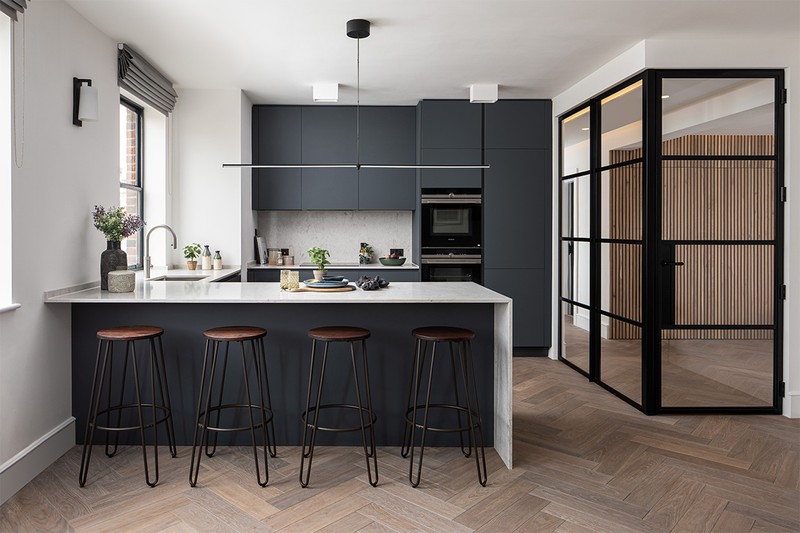

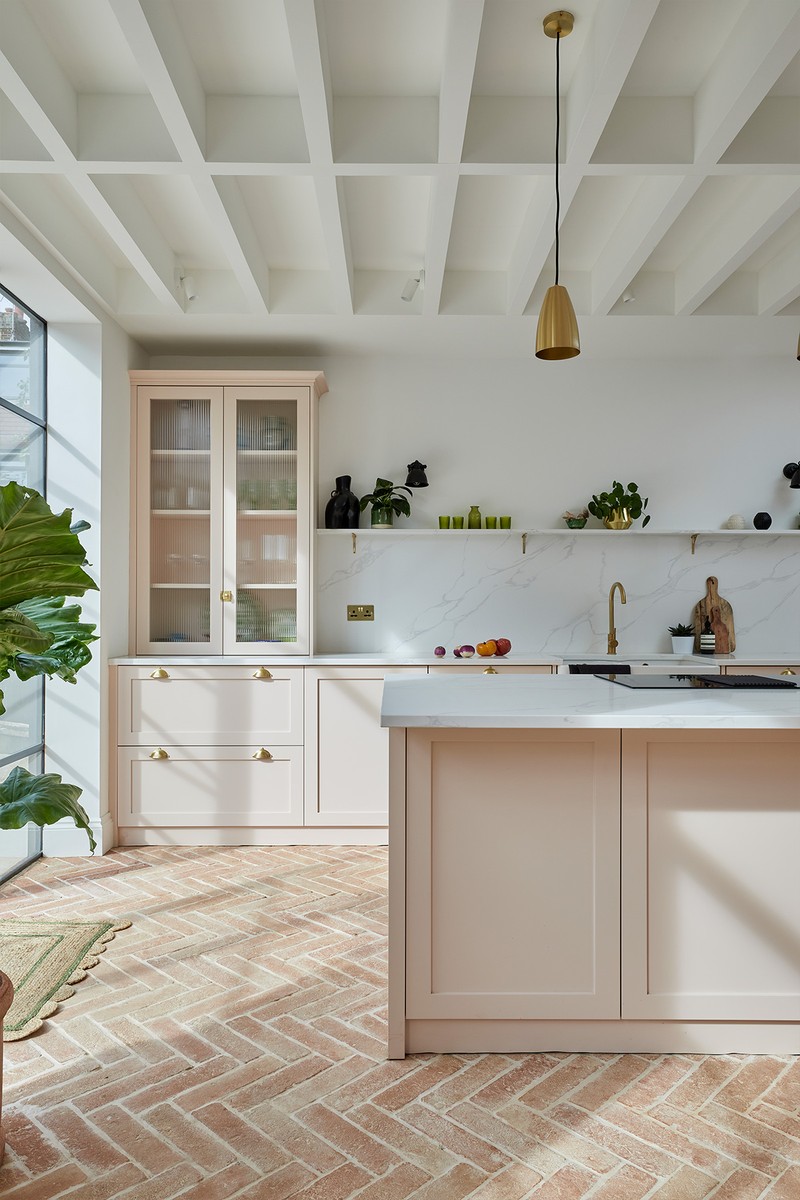
TERRACOTTA
“From its baked clay tones that warm up any room to its earthy texture that’s just the right balance between rugged and refined, it’s no wonder terracotta is a forever trend, especially in kitchens.
“The beauty of terracotta (aside from its Siena-style colouring) is that it builds up a patina over time. In other words, the more you use it and the older it gets, the better and more characterful it will look. That means you don’t need to be precious when it comes to living in close quarters with terracotta tiling. To clean it, vacuuming is best, but if you need to do any spot cleaning – muddy paw prints, for example – a stiff-bristled brush will do the job. For a deeper clean, you can mop terracotta – just make sure it’s with as little water as possible.
“If you get your terracotta sealed, it’ll form a liquid wax on the surface to protect it from staining. Terracotta is robust, but it’s not bullet proof, so harsh chemicals or hot oil are likely to cause it to mark. Remember, if you do end up marking your terracotta, it can become part of its story. Embrace living with it in a laidback way and your terracotta will, over the years, become richer.
“Typically, our terracotta tiles are all 20mm thick, making them highly abrasive; they’re never going to wear thin. That’s why you see reclaimed terracotta in so many warehouse conversions and in period properties – it lasts the course. It also works wonderfully with underfloor heating.”
- Grazzie
DISCLAIMER: We endeavour to always credit the correct original source of every image we use. If you think a credit may be incorrect, please contact us at info@sheerluxe.com.
